The Plextor M8Pe (512GB) SSD Review
by Billy Tallis on December 14, 2016 9:00 AM ESTATTO
ATTO's Disk Benchmark is a quick and easy freeware tool to measure drive performance across various transfer sizes.
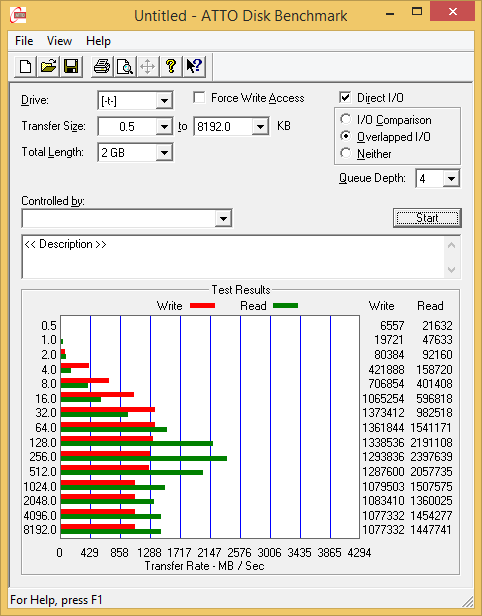 |
|||||||||
The two configurations of the M8Pe ramp up identically as transfer size increases, but the M8PeGN without the heatsink starts throttling right after it hits full performance.
AS-SSD
AS-SSD is another quick and free benchmark tool. It uses incompressible data for all of its tests, making it an easy way to keep an eye on which drives are relying on transparent data compression. The short duration of the test makes it a decent indicator of peak drive performance.
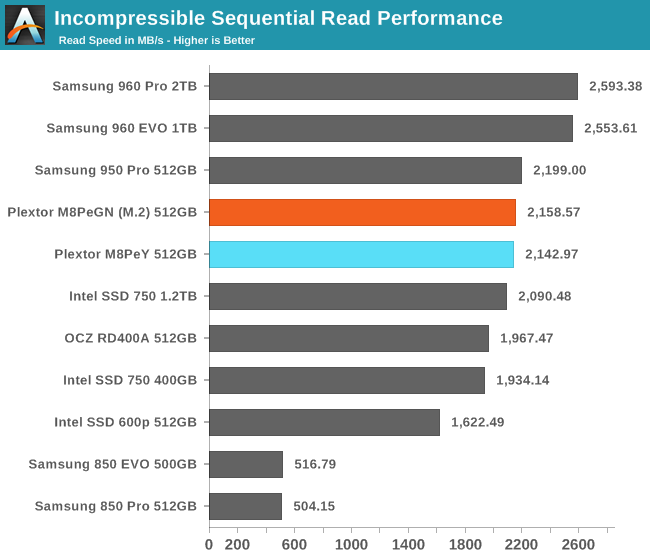
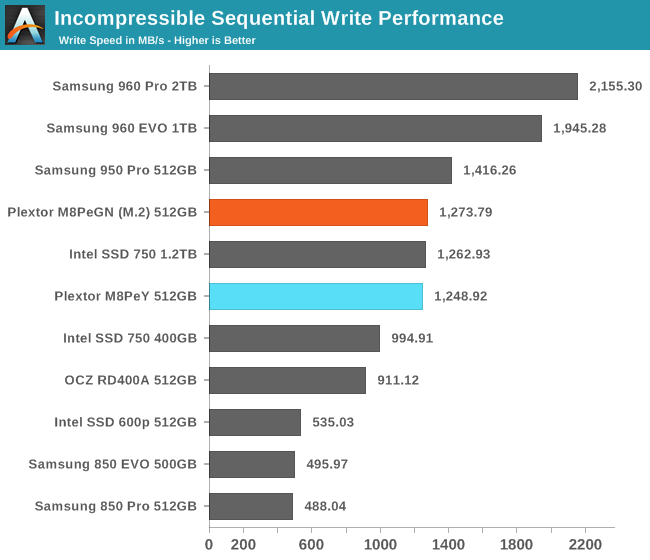
The M8Pe delivers short-duration sequential speeds that are second only to Samsung's PCIe SSDs, and tied with the much larger 1.2TB Intel SSD 750.
Idle Power Consumption
Since the ATSB tests based on real-world usage cut idle times short to 25ms, their power consumption scores paint an inaccurate picture of the relative suitability of drives for mobile use. During real-world client use, a solid state drive will spend far more time idle than actively processing commands.
There are two main ways that a NVMe SSD can save power when idle. The first is through suspending the PCIe link through the Active State Power Management (ASPM) mechanism, analogous to the SATA Link Power Management mechanism. Both define two power saving modes: an intermediate power saving mode with strict wake-up latency requirements (eg. 10µs for SATA "Partial" state) and a deeper state with looser wake-up requirements (eg. 10ms for SATA "Slumber" state). SATA Link Power Management is supported by almost all SSDs and host systems, though it is commonly off by default for desktops. PCIe ASPM support on the other hand is a minefield and it is common to encounter devices that do not implement it or implement it incorrectly. Forcing PCIe ASPM on for a system that defaults to disabling it may lead to the system locking up; this is the case for our current SSD testbed and thus we are unable to measure the effect of PCIe ASPM on SSD idle power.
The NVMe standard also defines a drive power management mechanism that is separate from PCIe link power management. The SSD can define up to 32 different power states and inform the host of the time taken to enter and exit these states. Some of these power states can be operational states where the drive continues to perform I/O with a restricted power budget, while others are non-operational idle states. The host system can either directly set these power states, or it can declare rules for which power states the drive may autonomously transition to after being idle for different lengths of time. NVMe power management including Autonomous Power State Transition (APST) fortunately does not depend on motherboard support the way PCIe ASPM does, so it should eventually reach the same widespread availability that SATA Link Power Management enjoys.
We report two idle power values for each drive: an active idle measurement taken with none of the above power management states engaged, and an idle power measurement with either SATA LPM Slumber state or the lowest-power NVMe non-operational power state, if supported.
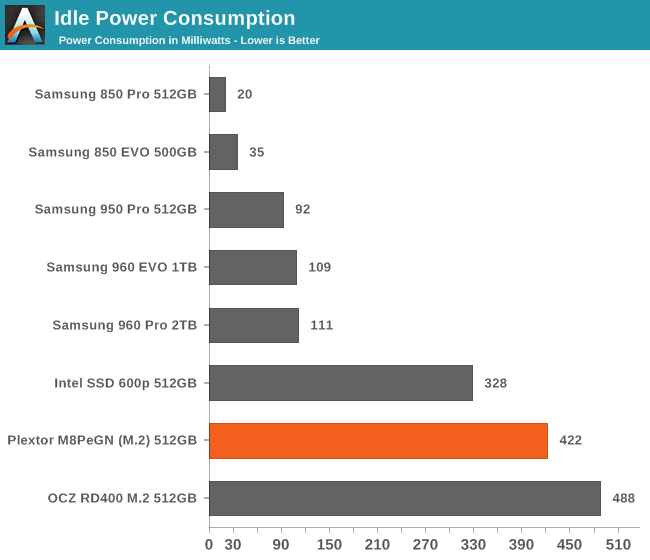
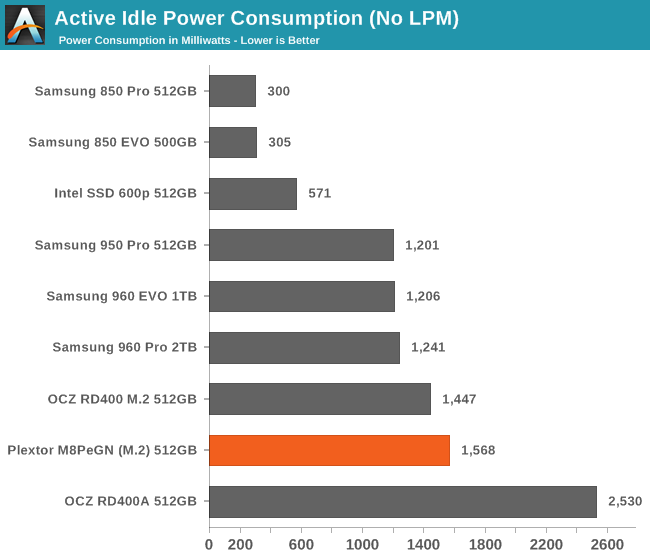
Samsung is still the only PCIe SSD vendor that has made significant progress with idle power management. Even when put into the lowest power state, The M8Pe (and the Intel 600p and OCZ RD400) consume more power than most idle SATA drives with no power saving features engaged.
When NVMe power management is not supported or not enabled, the Plextor M8Pe doesn't look too bad by comparison, as even Samsung's PCIe drives idle at 1.2 W compared to the M8Pe's 1.5 W.










64 Comments
View All Comments
close - Friday, December 16, 2016 - link
I'm not at all sure how dire the shortage is but there's plenty of online material for this. Of course, the titles might be apocalyptic but you can get a sense that it's not something to shrug off quite yet:http://www.digitimes.com/news/a20161212VL201.html
http://www.tomshardware.co.uk/ssd-hdd-shortage-nan...
https://www.custompcreview.com/news/nand-flash-pri...
https://epsnews.com/2016/10/12/supply-shortage-nan...
And this fits perfectly with the price trends for some SSDs. Crucial/Micron is a nice holdout but probably because of the in-house NAND manufacturing.
On a slightly unrelated note, while I consider Samsung's drives to deliver the highest performance (and use them because of this), I wouldn't say they are most balanced because of the price and implicitly the price/performance ratio. I still go with SanDisk and Crucial wherever top range performance isn't critical because I think they offer a lot more value.
jabber - Friday, December 16, 2016 - link
There is always a 'shortage' yet life and sales go on. Just market FUD too manipulate prices. Never seems to push through to retail much.shabby - Thursday, December 15, 2016 - link
Seems like you guys should be comparing every capacity of ssd when doing reviews, if samsung sends you only the 1tb version tell them where are the other two, because clearly they will be slower.Mr Perfect - Thursday, December 15, 2016 - link
Yes, and this could be played the other way, too. When Plextor sends in a 512GB drive, let them know that they'll be benched against a 1TB Samsung and will be at a disadvantage.Bruce427 - Friday, December 16, 2016 - link
The reason for the 1TB Samsung 960 EVO (only) is, at the time that 's all Samsung was shipping. I'm sure reviews on other models will follow soon.Billy Tallis - Thursday, December 15, 2016 - link
In the specific case of the 960 EVO, Samsung sent me a 1TB and a 250GB sample. The 250GB died, but I'm currently writing up the review of the replacement.Most of the companies and PR people I deal with are very understanding of my desire to test the full range of capacities. But for many product launches, the PR departments simply don't get enough supply to satisfy us reviewers. I can't even say that the executives several levels up who make those allocation decisions are wrong. Most of their benefit comes from the initial exposure of having the SSD reviewed at all. Providing a wider range of samples means they'll get mentioned more frequently as a point of comparison in future reviews, but that's a tough sell when it means a retailer like Newegg is more likely to run out before their second shipment comes in.
Some companies have indicated that they'd be open to providing further samples post-launch when supply is no longer constrained. But I'm not in a good position to ask for that when I still have a backlog of drives that haven't gotten a first review.
epobirs - Friday, December 16, 2016 - link
Also, don't be fooled by MSRP. I got the bare version of the Plextor for under $200 from Newegg recently. I wouldn't have been able to justify going PCIe with any other product I examined at the time.aeolist - Wednesday, December 14, 2016 - link
The 512GB M8Pe was $180 on Newegg over Black Friday, which made it a pretty easy choice for me. Keep an eye out over the holidays, I wouldn't be surprised to see it and the RD400 go on sale pretty significantly.icrf - Wednesday, December 14, 2016 - link
I did the same thing. And to clarify, it was the GN model, without the heat spreader. Aside from having a difficult time getting my Linux install copied over and booting properly, been happy with it, but haven't really stressed it yet.sinPiEqualsZero - Wednesday, December 14, 2016 - link
From a real-world perspective, are we at the point where we (meaning "the majority of humans") can tell the difference between an M.2 PCI-E and SATA drive during normal usage?I ask because I'm using a 1 GB ADATA drive that I picked up for $220 last year and it was a decent upgrade over my Crucial M4. I wonder if the jump from SATA to PCI-E is likewise noticeable.